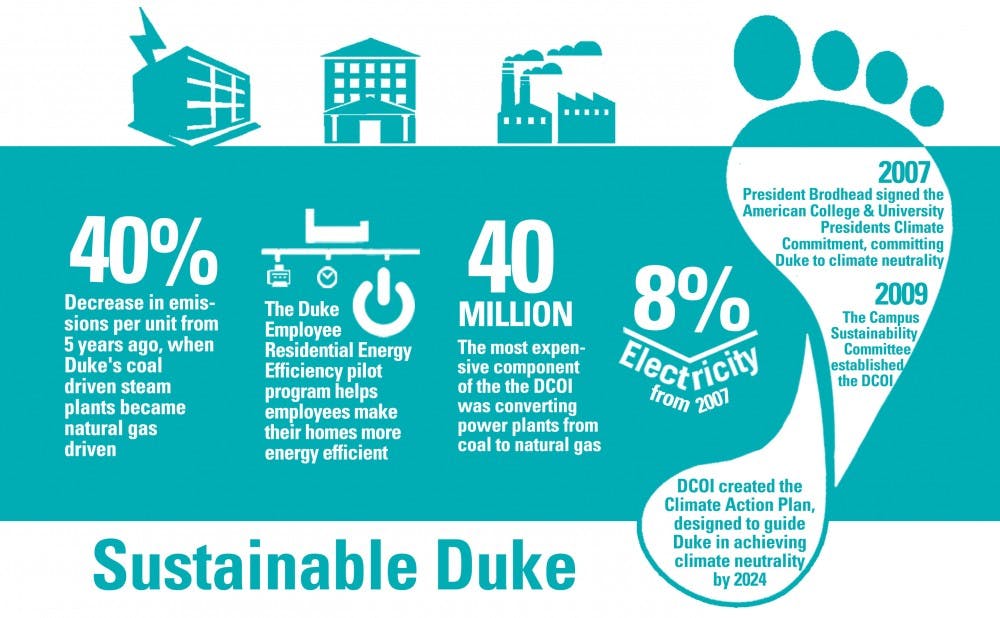Seven years after first pledging to become carbon neutral, Duke has shifted from lowering emissions through campus-level cuts to promoting environmentally-friendly choices for individuals.
The University began taking steps to reduce its carbon footprint in 2007, when President Richard Brodhead signed the American College and University Presidents Climate Commitment. Aiming for complete carbon neutrality by 2024, Duke has made progress both through community initiatives and through off-campus investments designed to offset campus emissions. Now, the University is on track to meet its original goal of reducing greenhouse gas emissions by 21 percent before January 2015—but looking ahead, Duke will have to transition from the campus-wide cuts it has made in the past to smaller and more targeted changes.
“We are on track to meet or exceed that milestone target," Environmental Sustainability Director Tavey Capps said of the 2015 goal. "However, future emission reductions will be increasingly reliant on individual choices around commuting, air travel and energy conservation.”
Campus-wide cuts and carbon offsets

Since the initiative began, "big cuts" have been made across the board, Executive Vice President Tallman Trask said. The most significant cut was eliminating coal use on campus, he noted—converting Duke's steam plants to use natural gas instead. The transition, which was completed in 2012, allowed the plants to curb their emissions by nearly 40 percent.
The transition has been the most expensive component of the carbon neutral campaign to date—costing approximately $40 million, Trask said.
University-wide progress has also come from decreasing electricity use—installing LED lamps and electric "smart meters" across campus. As a result, electricity usage has gone down by 8 percent since 2007, according to the 2013 Sustainability Progress Report. Duke has worked to make individual buildings more energy-efficient as well, by establishing a minimum standard of efficiency for all campus construction and renovation projects.
In addition to decreasing greenhouse gas emissions on campus, the University has taken steps to increase its carbon offsets—programs that allow other individuals and groups to lower their emissions.
"The idea is to help someone else increase their energy efficiency and reduce their carbon emissions, and then count those energy savings and offsets for our 2024 climate neutrality goal," said Charles Adair, program manager of the Duke Carbon Offsets Initiative.
DCOI has designed two pilot projects in recent years to increase carbon offsets. The Loyd Ray Farms project—in nearby Yadkin Country—is the current focus of the initiative's work. Duke made headlines in 2011 for partnering with Google to fund the program, which collects methane generated by hog waste and burns it in order to generate electricity.
The renewable energy offsets currently provided by Loyd Ray Farms, however, are only a small portion of what Duke needs in order to reach its goals. Trask noted that DCOI is currently brainstorming ideas in order to increase the effectiveness of the offsets.
The second pilot initiative launched by DCOI is the Duke Employee Residential Energy Efficiency program. Beginning this Fall, the program provides employees with funding and information to make their homes more energy efficient.
DCOI received funding for the program from the Charlotte-based Duke Endowment and the nonprofit Clinton Climate Initiative. Neighboring schools also helped to develop the project, including North Carolina State University and the Environmental Finance Center at the University of North Carolina at Chapel Hill.
Adair noted that if these pilot programs are successful, the next step for DCOI will be to replicate them on a larger scale.
The road ahead

But several obstacles remain in the way of complete carbon neutrality for Duke. Chief among these are greenhouse gas emissions related to transportation. Due to the layout of Duke's campus, cars and buses are necessary—making these emissions difficult for the Campus Sustainability Committee to tackle, Trask said.
Since 2007, greenhouse gas emissions from employees' commutes have risen by 15 percent—due both to an increase in Duke's workforce and to more employees living further away, according to the 2013 Sustainability Progress Report.
“Cars around here are a necessary evil,” Trask noted. "[The Triangle Area] does not really have an efficient public transportation system. We're in discussion with Triangle Transit about re-doing bus routes and trying to make them more convenient for people."
As of 2013, nearly three-quarters of Duke employees drove to work alone, according to the Sustainability Progress Report.
Another obstacle for Duke lies in the cost of going carbon-neutral—but finances have become a less prohibitive issue as time has passed, Trask noted. Though cost previously posed challenges for the Campus Sustainability Committee's progress, Trask said that expenses are becoming a less significant problem as Duke switches from campus-wide cuts to alternative changes.
The $40 million steam plant transition from coal to natural gas in 2012 is projected to be the largest cost associated with Duke's carbon neutrality goal.
The costs for continuing work with carbon offsets, however, remains to be seen.
"It will not be that much money when all is said and done, but trying to predict what the markets [for buying offsets] will be like in ten years is difficult," Trask said. "I think it will be hundreds of thousands of dollars, not millions of dollars.”
Trask added that it is possible that Duke will be able to produce enough of its own carbon offsets by 2024 that the University will not have to purchase more past that point.
“It’s exciting because we’re doing all these projects and we're able to involve students in the research and implementation, allowing us to develop larger projects that can help us reach our goal,” Adair said.?
Get The Chronicle straight to your inbox
Signup for our weekly newsletter. Cancel at any time.

